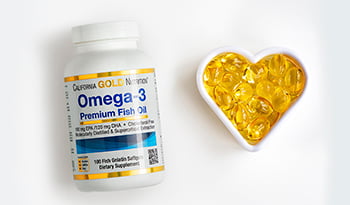5 Tips To Help You Support Heart Health
ESONERO DI RESPONSABILITÀ:Questo blog non intende fornire diagnosi...
- In this article:
- About Cholesterol, The Good and The Bad
- Tip #1: Diet Is Key
- Tip #2: Green Tea Extract
- Tip #3: Omega 3 Fatty Acids
- Tip #4: Ginger
- Tip #5: Garlic
- Takeaway

Cardiovascular disease (CVD) is the leading cause of death globally, with a yearly mortality rate of nearly 18 million people. There are many risk factors for CVD, one of them including high cholesterol levels. According to a journal report from the New England Journal of Medicine, the rates of “bad” cholesterol, Low-Density Lipoprotein (LDL), have risen in the past 38 years, particularly affecting countries in East and Southeast Asia. In 2017, elevated LDL levels led to one-third of the preventable deaths from heart attacks and strokes.
The effects of elevated LDL cholesterol are preventable through a healthy diet, exercise, and supplements like green tea extract, omega-3 fatty acids, ginger, and garlic. Therefore, there is no better time than September to start learning how to minimize your risk of developing CVD since September is National Cholesterol Education Month.
About Cholesterol, The Good and The Bad
Cholesterol is an essential part of our bodies and plays many roles in the normal function of our cells. It is one of the main building blocks of cell membranes. Cholesterol is also the building block for vitamin D and hormones like cortisol, estrogen, testosterone, and progesterone. Cholesterol also helps with digesting fat-soluble vitamins like Vitamin A, D, E, and K. Cholesterol travels throughout the body in the blood in different forms. The two main clinically significant ones are High-Density Lipoprotein (HDL) or the good cholesterol and Low-Density Lipoprotein (LDL) or the bad cholesterol.
LDL has contributed to the increased risk of developing atherosclerotic plaque in the blood vessels. It functions to transport cholesterol around the body, and when it’s not needed to repair cells, it gets stored in the artery walls. These plaques have drastic negative health effects, including heart attacks, peripheral artery disease, aortic aneurysms, and even strokes. On the other hand, HDL is known as the “good cholesterol” because it transports cholesterol from our tissues to our liver, has anti-inflammatory properties, and helps dissolve atherosclerotic plaques that are stuck in our arterial walls.
When you get your yearly check-up and get told you have high cholesterol, physicians typically refer to high LDL levels as anything higher than 160mg/dL. Even having an LDL level between 100 – 150mg/dL puts you at a 30 – 40% increase of CVD, especially in young adults. Your HDL may or may not be high, but having higher LDL levels can put you at risk of developing CVD. Thus, it is vital to eat healthily, exercise, avoid tobacco, and you may even benefit from the four supplements below.
Tip #1: Diet Is Key
According to the American Heart Association, the best way to help lower your cholesterol is to limit your consumption of saturated and trans fats. Some of the foods involved in this diet modification include:
- Reducing intake of red meat.
- Reducing intake of dairy, including whole milk and cheese.
- Reducing intake of fried food.
A healthy diet includes fruit and vegetables, whole grains, chicken, fish, nuts, and healthy vegetable oils, and limiting red and processed meats, salt, sugar, and sweetened beverages.
Know your fats — remember, saturated and trans fats tend to raise the undesired type of cholesterol. Being more physically active helps increase your HDL levels. Finally, smoking and even vaping drastically reduce your HDL levels. So, if you want to keep your HDL level elevated, avoid using any tobacco product.
Yet, if you’ve done the lifestyle changes and are still needing some help with keeping your LDL levels low, then the following supplements may give you that extra edge you need:
Tip #2: Green Tea Extract
Green tea is derived from the leaves from the plant Camellia sinensis and gets consumed worldwide. In some countries, it is used for medicinal purposes. It has antioxidants and14 polyphenols that may help decrease the risk of CVD. A review of 14 studies that examined the consumption of green tea drinks and green tea extract supplements revealed that they helped reduce the total cholesterol and LDL levels in the blood.
One of the ways that green tea may help reduce LDL levels is by preventing the absorption of cholesterol and reducing liver cholesterol. Antioxidant molecules called catechins found in green tea may also help prevent the synthesis of cholesterol. But since green tea extract has not been shown to help increase your HDL levels, you may need to try other supplements which may help you raise your good cholesterol.
Tip #3: Omega 3 Fatty Acids
Polyunsaturated fatty acids (PUFAs) like omega-3 and 6 make up an important part of our body, such as the cell membrane structure of our brain, eyes, and other organs. Importantly, PUFAs like Omega-3 fatty acids help regulate inflammation, which might increase the risk of developing atherosclerotic plaque.
In an epidemiological study of the Greenland population, inhabitants showed lower rates of CVD, likely due to their high consumption of fish and fish oils. In this study, researchers analyzed the concentration of omega 3 and 6 fatty acids in the blood. They found that those with higher levels of omega-3 fatty acids had higher levels of HDL. Omega-3 fatty acids may also reduce LDL levels and therefore prevent the development of atherosclerotic plaque.
The Food and Drug Administration (FDA) has approved omega-3 fatty acid usage to help regulate high blood cholesterol. The dosage recommended according to the FDA is 4 grams per day of Omega 3 fatty acids. It is typically consumed in 2-gram capsules twice a day. These supplements have been listed as generally safe by the FDA.
Tip #4: Ginger
One of the best-known spices used historically for its health benefits is ginger. It has beneficial antioxidant properties that may have cholesterol-lowering effects. In an animal study in the Journal of Nutrition by Fuhrman et al., supplementing mice with 250 micrograms of ginger extract per day showed a reduction in atherosclerotic plaque by 44%. That amount of ginger also reduced LDL levels, indicating that supplementing with ginger daily may help reduce your risk of developing CVD and reduce your LDL levels.
Tip #5: Garlic
Garlic is another herb with a long culinary history and potential medicinal benefits in Indian and Chinese cultures. In a review of 14 clinical articles by Sun et al., garlic consumption may help decrease LDL cholesterol levels. It has been postulated that garlic may lower cholesterol absorption in the gut and the liver, and it did not show any impact on the good cholesterol, HDL. For adults, 4 grams of whole garlic is recommended per day, or 300mg of dried garlic powder extract tablets.
Takeaway
As you prepare for National Cholesterol Education Month, the most critical step is to make an appointment with your doctor for a yearly physical. Information is vital, so when you have your test result, you can start making the lifestyle changes you need or start seeing what dietary supplement may help you normalize your cholesterol levels. Remember, CVD and high LDL are preventable. Try and make it a priority to eat healthy, exercise, avoid tobacco products, minimize alcohol consumption, and if needed, use supplements like green tea, omega 3s, and ginger and garlic to keep your cholesterol under control.
References:
- Fuhrman B, Rosenblat M, Hayek T, Coleman R, Aviram M. Ginger extract consumption reduces plasma cholesterol, inhibits LDL oxidation and attenuates development of atherosclerosis in atherosclerotic, apolipoprotein E-deficient mice. J Nutr. 2000;130(5):1124-1131. doi:10.1093/jn/130.5.1124.
- Huff T, Boyd B, Jialal I. Physiology, Cholesterol. In: StatPearls. Treasure Island (FL):2021.
- NEJM Journal Watch: Summaries of and commentary on original medical and scientific articles from key medical journals. https://www.jwatch.org/na51768/2020/06/17/worldwide-trends-cholesterol-levels.
- Novotny K, Fritz K, Parmar M. Omega-3 Fatty Acids. In: StatPearls. Treasure Island (FL):2021.
- Pirahanchi Y, Sinawe H, Dimri M. Biochemistry, LDL Cholesterol. [Updated 2020 Sep 8]. In: StatPearls [Internet]. Treasure Island (FL): StatPearls Publishing; 2021 Jan-
- Sun YE, Wang W, Qin J. Anti-hyperlipidemia of garlic by reducing the level of total cholesterol and low-density lipoprotein: A meta-analysis. Medicine (Baltimore). 2018;97(18):e0255. doi:10.1097/MD.0000000000010255
- Yanai H, Masui Y, Katsuyama H, et al. An Improvement of Cardiovascular Risk Factors by Omega-3 Polyunsaturated Fatty Acids. J Clin Med Res. 2018;10(4):281-289. doi:10.14740/jocmr3362w
- Zheng XX, Xu YL, Li SH, Liu XX, Hui R, Huang XH. Green tea intake lowers fasting serum total and LDL cholesterol in adults: a meta-analysis of 14 randomized controlled trials. Am J Clin Nutr. 2011;94(2):601-610. doi:10.3945/ajcn.110.010926
- Cardiovascular diseases. World Health Organization. https://www.who.int/health-topics/cardiovascular-diseases/#tab=tab_1.

 By Dott. Gabriel Espinoza, Medico
By Dott. Gabriel Espinoza, Medico


